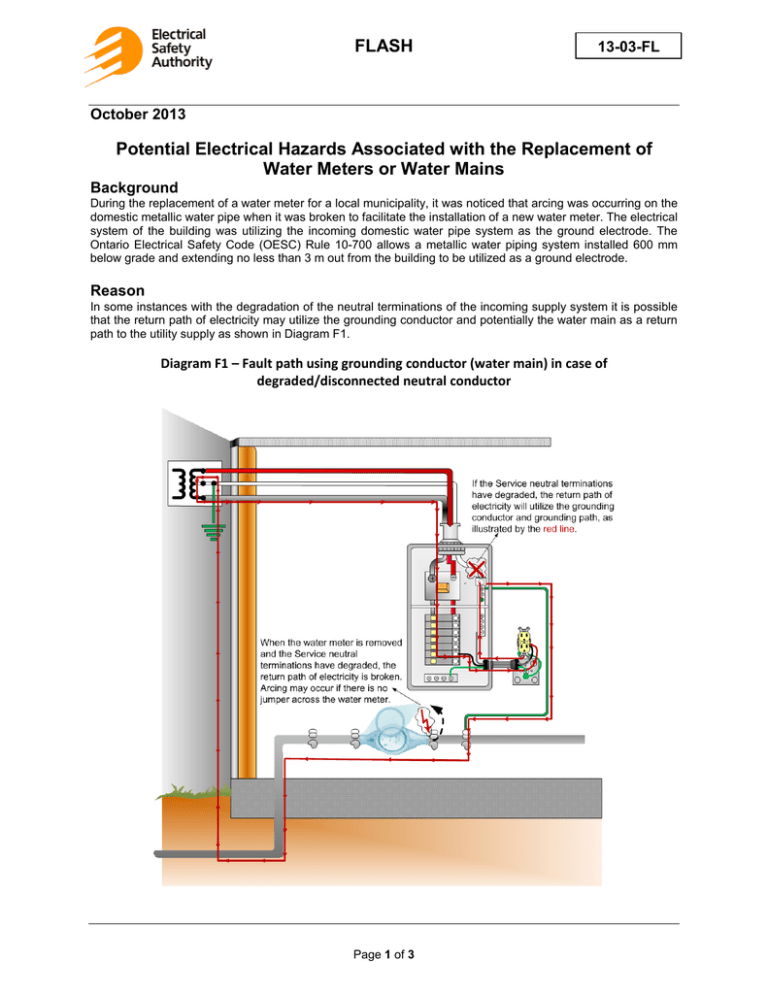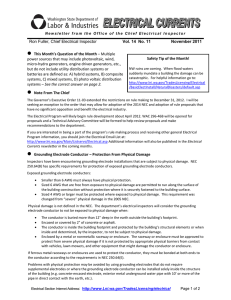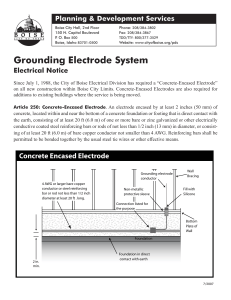FLASH \\ Potential Electrical Hazards Associated with the
advertisement

FLASH 13-03-FL \\ October 2013 Potential Electrical Hazards Associated with the Replacement of Water Meters or Water Mains Background During the replacement of a water meter for a local municipality, it was noticed that arcing was occurring on the domestic metallic water pipe when it was broken to facilitate the installation of a new water meter. The electrical system of the building was utilizing the incoming domestic water pipe system as the ground electrode. The Ontario Electrical Safety Code (OESC) Rule 10-700 allows a metallic water piping system installed 600 mm below grade and extending no less than 3 m out from the building to be utilized as a ground electrode. Reason In some instances with the degradation of the neutral terminations of the incoming supply system it is possible that the return path of electricity may utilize the grounding conductor and potentially the water main as a return path to the utility supply as shown in Diagram F1. Diagram F1 – Fault path using grounding conductor (water main) in case of degraded/disconnected neutral conductor Page 1 of 3 FLASH 13-03-FL \\ CAUTION An indicator that service neutral terminations may be degrading is indeed the arcing of the grounding conductor at the electrode or the breaking of the electrode in mid path as may occur when the water meter is replaced or the incoming domestic water pipe is broken. This arcing on the water main is indicative of a more serious problem with the electrical system which requires investigation by a Licensed Electrical Contractor (LEC). The LEC will need to determine if the electrical wiring in the building is compliant with the OESC. The supply authority should only be notified after the LEC has determined the arcing is from external sources. Extreme care must be taken when replacing water meters or incoming domestic water mains. The potential of an electrical shock may be realized under conditions of service neutral failure. Recommendation It is imperative that the integrity of the electrical system grounding electrode be kept intact when the replacement of domestic water meters is carried out. The installation of a temporary grounding jumper (minimum #6 AWG copper wire*) across the water meter would be adequate to ensure the continuity of the grounding electrode is maintained with this type of work. (*) Note: For the installation of the temporary grounding jumper over the water meter, the installation of common automotive battery jumper cables would be an acceptable work procedure/practice as shown in the Photo B1, and would be permitted to be performed by the trade completing the upgrade of the water meter. Photo B1 – Using automotive battery cables for temporary grounding jumper Page 2 of 3 FLASH 13-03-FL \\ Replacement water meter of the non-conductive type The OESC Rule 10-902 stipulates when utilizing a domestic metallic water main in conformance with OESC Rule 10-700 as an electrode, that the grounding conductor from the building electrical system shall be installed on the street side of the water meter; or on a cold-water pipe of adequate ampacity and as near as practicable to the point of entrance of the water service in the building. It further stipulates that the metal cold-water system shall be made electrically continuous from the point of attachment of the grounding conductor to the water service entrance by bonding together all parts that contain insulating sections or that may become disconnected at such locations as meters, valves and unions. When the replacement water meter is non-conductive and the grounding conductor terminates on the domestic side of the water meter, then a bonding jumper is required to be installed as per OESC 10-902, see Photo B2. Photo B2 – Installed bonding jumper between both sides of non-conductive water meter when using the water main as grounding electrode Replacement of metallic water main with a non-metallic piping A more difficult situation may arise with the replacement of the incoming metallic water main as a whole when being upgraded and replaced with a non-metallic water main. In this type of upgrade the metallic water pipe is being eliminated completely and as such is also eliminating the building grounding system electrode. In this type of installation a new electrode in conformance with Rule 10-700 of the OESC must be installed prior to the breaking of the continuity of the existing grounding conductor and metallic water main electrode. Note: For the installation of a new electrical system electrode, a licensed electrical contractor who conforms to Ontario Regulation 570/05 is required to complete the work. Page 3 of 3



